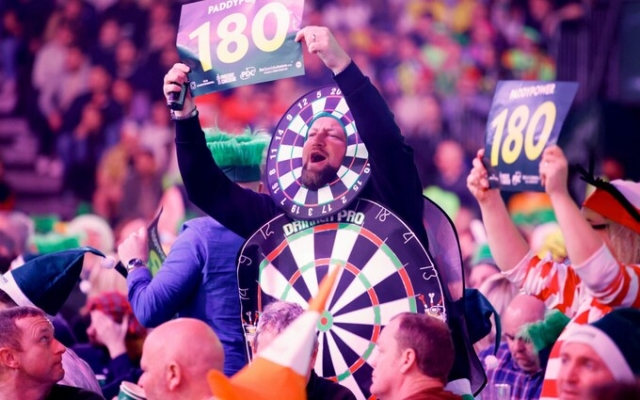 Darts fans show their devotion at the World Championships at Alexandra Palace in London. Photo: Shutterstock/David Cliff
Darts fans show their devotion at the World Championships at Alexandra Palace in London. Photo: Shutterstock/David Cliff
The moment the Luke Littler Phenomenon exploded out of reality was when he started drawing parallels with Tiger Woods. Barry Hearn, who likes to call darts «golf for workers», seems convinced that the teenager's World Championship victory this year represents the «Tiger moment» of our time.
At 75, Hearn has lost none of his brilliant salesman style. But his latest comparison is as tiresome as Sid Waddell comparing the noise of Eric Bristow's match to the sounds of Pompeii being flooded with lava — and about as plausible.
Woods, who turned the “Hello, World!” in his first Nike commercial, a record 12-stroke triumph at the Masters at age 21, became an athlete for the ages. The key word here is “athlete,” and Woods is breaking down preconceptions about his sport through his dedication to fitness. By 1997, he began his mornings by running four miles and lifting weights. In the afternoon he walked to the range for two hours and played 18 holes, and by sunset he ran another four miles. It was deliberate perfectionism: He showed up at Augusta and hit the ball 25 yards further than anyone else on the field.
You struggle to imagine a similar performance gain in darts. As if to reinforce this point, 16-year-old Littler described his daily routine this way: “Wake up, play Xbox, eat, play on the board, go to bed. That's all.»
He celebrated his victories at Alexandra Palace with kebabs and cola. All this naturally adds to the relevance of Littler's story, the boy's adventure when the teenager earned a six-figure check and promised to spend it on a trip to Alton Towers. His success is worthy of the widest celebration. What he doesn't guarantee is a place on the same pedestal with Pele, Woods, Mike Tyson or all the other prodigies whose exploits included physical sacrifice.
 16-year-old Brit Luke Littler covers the World Darts Championship… Photo: PA/Zac Goodwin “It's a wink in the bear pit»
16-year-old Brit Luke Littler covers the World Darts Championship… Photo: PA/Zac Goodwin “It's a wink in the bear pit»
Darts' right to be called a sport has been endlessly contested, even by those devoted to its original spit-and-sawdust allure. The late Martin Amis wove all aspects of darts culture into his novel London Fields, viewing the game as «the crudest possible form of human endeavour» and reputedly naming the main character Keith Talent after Keith Deller, the 1983 world champion. Trying to explain why he fell in love with this world, he said: “On a tiny scale, it is elemental. It's really fun in the bear pit.
It's a nice line, but if you're going to use winks as a guide, isn't the argument for sports recognition already lost?
At some level, darts has moved away from this debate. In 2005, the English Institute of Sports awarded the award that domestic tungsten throwers had long sought, officially calling their pastime a sport. Euphoric Martin Adams put himself on par with Geoff Capes, the former World's Strongest Man, saying: “He stood still and threw pieces of metal. If he can become a sports hero, then so can I.”
Phil Taylor later recalled that he valued his second place in the BBC Sports Personality of the Year award in 2010 more than any of his 16 world titles.
But then, the debate about darts' borderline status between sport and pub hobby has never died down. No sooner had he secured sporting legitimacy than Bridge launched a legal challenge demanding the same. And with Littler's emergence, his true essence has come under renewed scrutiny for the simple reason that none of his principles, from training to diet, correspond to what we expect from an athletic prodigy.
Videos uploaded by his sister Littler in a diaper throwing darts at a magnetic board are a testament to how seriously he takes his craft. But this is not valor based on physical effort. It's the mastery and memorization of fine motor skills to the point where he can stack three arrows repeatedly in the stock of a triple 20 at will. All of this is admirable, especially when performing in front of thousands of drunk players.
























































Свежие комментарии